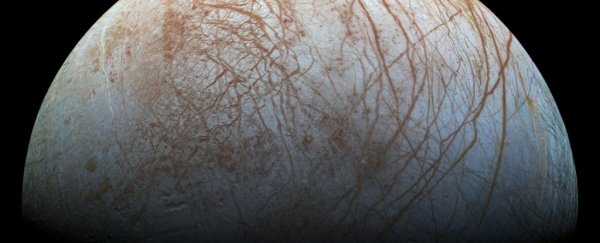NASA is at it again. The US space agency is holding another cryptic press conference that will reveal new findings about water worlds in our Solar System.
You can watch the whole thing live below via NASA TV, starting at 2pm ET (6pm UTC) Thursday 13 April 2017 (4am AEST Friday 14 April 2017).
The press release doesn't give away many clues, but says the results will "inform future ocean world exploration - including NASA's upcoming Europa Clipper mission planned for launch in the 2020s - and the broader search for life beyond Earth". Okay, we're intrigued…

So far, all we know is that the discoveries are based on data taken from both the Hubble Space Telescope and the Cassini mission, which has been exploring Saturn and its satellites for the past 13 years, and is scheduled to plummet to its death this September.
The announcement will be made to the public at 2pm ET (6pm UTC) Thursday 13 April 2017, and you can watch the whole thing live below.
But other than those scant details, the space agency has remained tight-lipped.
Before you get too excited, the wording of the release makes it unlikely that this will be an announcement about any kind of direct discovery of life on one of our Solar System's ocean worlds.
Instead, it sounds like whatever the researchers have found could change where and how we look for life in the future.
But of particular interest is the fact that the announcement specifically mentions Europa - one of Jupiter's 63 known moons, and one of the best candidates within our Solar System to host alien life.
For those who aren't familiar with Europa, the moon is just a little smaller than our own Moon, with a diameter of 3,120 km (1,940 miles).
What makes it really compelling is researchers suspect that beneath Europa's icy surface lies a huge, liquid ocean - estimated to be up to 10 times deeper than Earth's oceans.

In fact, telescope data suggests that Europa might hold two to three times more liquid water than Earth, making it a pretty prime spot to go looking for life.
The moon is a pretty icy 780 million km (485 million miles) from the Sun, but because the ocean is believed to be in contact with Europa's rocky mantle, it's believed that geothermal activity could be keeping the water warm and potentially even seeding the ingredients for alien life within our Solar System.
Based on that information, the science world naturally freaked out when NASA announced back in 2015 that it would finally be sending a mission to Titan, and hopefully Thursday's announcement will give researchers more guidance about where to start looking for life.
The only other information we have for now is who'll be speaking at the press conference:
- Thomas Zurbuchen, associate administrator, Science Mission Directorate at NASA Headquarters in Washington
- Jim Green, director, Planetary Science Division at NASA Headquarters
- Mary Voytek, astrobiology senior scientist at NASA Headquarters
- Linda Spilker, Cassini project scientist at NASA's Jet Propulsion Laboratory in Pasadena, California
- Hunter Waite, Cassini Ion and Neutral Mass Spectrometer team lead at the Southwest Research Institute (SwRI) in San Antonio
- Chris Glein, Cassini INMS team associate at SwRI
- William Sparks, astronomer with the Space Telescope Science Institute in Baltimore
Happy viewing! We'll be updating the site with the news as soon as we have it.
